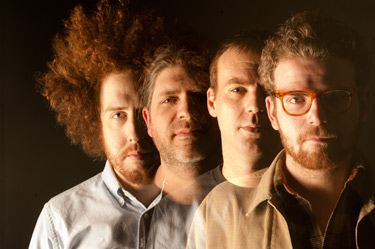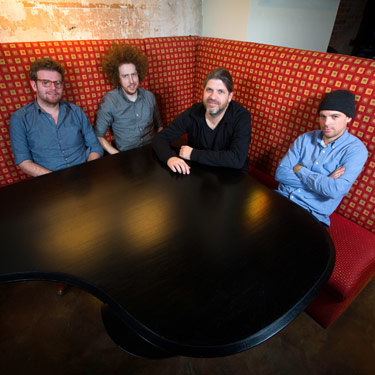Gypsy Jazz and More from Stephane Wrembel at MIM Oct 25th
An Interview By Mariah Fleming

In the 20th century, the guitar work of Django Rheinhardt defined Gypsy Jazz. In the 21st century, French born guitarist and composer Stephane Wrembel, who became known for his Reinhardt inspired playing, seems poised to make his own indelible mark on jazz…and more. Like Reinhardt, the Brooklyn based Wrembel learned his craft in the French countryside among the Romanies at campsites along the French countryside. Wrembel has expanded upon those Romani roots, transcending any boundaries. And this remarkable guitarist brings his music to the Musical Instrument Museum on October 25th at 7:30pm. Tickets are available at TheMIM.org. The superb MIM concert theatre is the perfect setting for Wrembel's enchanting music.
Rolling Stone has called Wrembel's music 'a revelation.' Wrembel's multi faceted work is some of the most original in contemporary music. Now based in Brooklyn, he moved to the United States in 2000 and his career has rapidly moved skyward. He worked with Woody Allen on "Vicky, Cristina, Barcelona" and Allen recruited Wrembel to write the score for 2012's Academy Award winning film "Midnight in Paris." Wrembel has performed all over the world, including as a cultural ambassador to Nigeria for the US State Department’s “International Language of Jazz for Peace” program. We touched on this and many other subjects in the following interview.
Q. Historically, France has been a mecca for jazz artists, especially when black artists left the US pre-Civil Rights Act, due to racism and segregation in the States. Is the opportunity and appreciation for jazz artists in France different than it is in the United States?
A. Jazz came to France in the first half of the 20th century. It was very popular back then, and influenced people in France to create a "genre" called "musiques improvisees". American jazz is still a bit popular, not as much as it used to be. Now people create their own thing over there, influenced a lot by Django Reinhardt, classical music, African and north African music. The French culture is naturally infused with Impressionism, and it gives a very special angle to the music.
Q. Do you come from a musical family? Did you grow up listening to jazz?
A. My mother played a bit of piano, and she insisted on us having a classical training. I was mainly listening to Pink Floyd and other 70s rock bands. I discovered Django when I was 19, and jazz when I was 20. I always saw jazz as an interesting school for improvisation techniques, but my soul is too ingrained in Impressionism to really embrace jazz culturally.
Q. Your career seems to have moved rapidly. When and why did you come to the States and where did you first play in the US?
A. I first came to the USA in September 2000, to study at Berklee College of music. Then in April 2000, I moved to NYC, this is when my career officially started, even if I played hundreds of gigs before that. NYC became my base, and my laboratory for exploration of the multiplicity of forms of music. For a few years I played an average of 350 gigs in the city. This is how I developed my skill and my style; exploration and intense performing.
Q. How did you wind up having your music used for Woody Allen's movie 'Midnight in Paris'?
A. I already worked on "Vicky Cristina Barcelona", so they called me again to see if I could compose a theme that would capture the soul and magic of Paris, and voila!
Q. When did you first hear Django Reinhart? Who are some of your biggest musical influences?
A. I heard him for the first time around 1993. Actually his music is part of the French landscape, so it was always hanging there, but when I was 19 and made the decision to become a professional, then I really paid attention, started transcribing, and Listening to him, with a big "L." Some of my main influences are Pink Floyd, Erkan Ogur (eskyia), Frank Zappa, Django Reinhardt, Ralph Towner (the solo stuff), Rabin Abou Khalil (yara), Ry Cooder (Paris Texas), Jim Campilongo (Orange), Neko Case (Blacklisted), Meshell N'degeoshello (Dance of the Infidels), John Coltrane, the French impressionists (Satie, Debussy, Ravel, Faure) and Chopin.
Q. You performed in Nigeria as part of the US State Department's International Language of Jazz for Peace program. How did you become involved in this program?
A. One night I received a call from a former student who works in medical research in Africa for the government. It was 3am (I still remember it!), so the guy wakes me up, I'm completely asleep, and he shouts "Stephane! Do you want to come and tour in Nigeria???" That's how it started...
Q. Were you exposed to indigenous music in Nigeria and did you find indigenous instruments you might like to integrate into your music?
A. Not really. We were in Abuja and Jos, which are pretty big cities. The country is very dangerous; we were in constant security check, so we could not adventure anywhere. We got to see some real amazing Afro beat though...that was something else!
Q. What are your strongest impressions/memories of your trip to Nigeria?
A. The people are so nice, their heart is so big, they have nothing, and they still give you something. I can't describe the amazing spirit of the place. The road to Jos with the army and secret services was epic, and the trip to the orphanage to give the kids balloons and play soccer with them is one of the most soulful experiences of my entire life. Part of my soul stayed in Nigeria.
Q. Where in Nigeria did you play?
A. At the institute of Film in Jos, for the international jazz festival of Abuja, various schools and embassy events, including the 4th of July.
Q. Were the people in Nigeria receptive?
A. Yes! I am always amazed to see how people are receptive to our music wherever continent or country we go!
Q. Did you play with any Nigerian artists while you were there?
A. With King Fage, Esso Rock band, and Baba 2010
Q. Are there musicians you met from Nigeria you'd like to work with?
A. The three above, and a myriad of incredible singers songwriters. They were all amazing, I could not even remember all their names!
Q. Thus far in your career, what gig stands out as being the most unusual or memorable, and why?
A. Out of 4000 concerts over the past 10 years it is hard to say. I really have a good memory of the Lincoln Center show, Rochester Jazz Festival, all my Barbes gigs, Yoshi's, the MIM. It is hard to name them all! The National Concert Hall in Dublin was awesome, so were the venues in South Korea and Nigeria...tough question!
Q. Getting back to your roots, where did you live in France and at what age did he begin to play?
A. I grew up in the Fontainebleau area, a critical place for French culture. This was the home of the kings, the place of arrival of Renaissance art in the 16th century, the birthplace of Impressionism, Django Reinhardt's home. I started piano at age 4 with Gilberte Lecomte, who was a world reknown specialist of Impressionism, friend and colleague of Stravinsky, Gabriel Faure and Nadia Boulanger. At 15 I had an urge to start guitar to play Pink Floyd. Then it became an obsession and a quest to absorb as much language as possible. To this day the quest is still on!
October 17, 2013
Contact the author of this article at Editor@MusicAndMoreAZ.com.